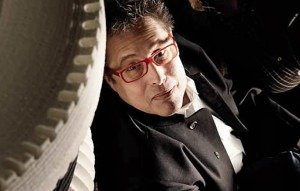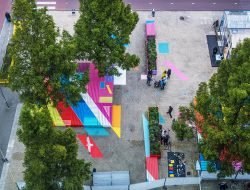The project to reassign the Citroën Garage, near Yser, rekindled the debate about the Place de l’Art in Brussels. How should the absence of a contemporary art museum of international scale in the capital of Europe be interpreted by visitors and other inquiring people? “Keep going, there’s nothing to see?” Surely not. Follow the guide.
Would contemporary art be unloved by the capital of Europe? New York with its MoMA, London with its MOCA, Paris with its Centre Pompidou, Bilbao with its Guggenheim. There is no shortage of examples. Elsewhere in Belgium, Gand has the S.M.A.K., Charleroi the BPS 22, the Grand Hornu has the MACs and Anvers the MuKHA. But what about Brussels? The answer is clear: the capital of Belgium has no real contemporary art museum. Since 2011 and the opening of the Musée Fin de Siècle, the contemporary collection of the Musées Royaux des Beaux-Arts has met a very sad end: it has been stored in the building’s cellars.
“It’s a lamentable situation for a city of Brussels’ rank”, complains Jacinthe Gigou, director of Arkadia, a non-profit organisation that shows off Brussels’ architectural heritage and contemporary art through guided tours, conferences, teaching workshops, etc. “Fortunately, there are many other places where contemporary art is exhibited. But these are often private or commercial initiatives.” Paradoxically, Brussels has a pretty sound contemporary art reputation internationally. Its public is considered to be quite expert and above all highly inquisitive about new art; the number of galleries is on the increase due to the availability of premises at moderate rents compared to those of Paris and London. Many artists come and establish themselves here.
“I would say Brussels is one of the Cities with the largest number of contemporary art collectors per square metre” adds Thierry Lambot, founder of the Neos collectors group and consultant to investors wishing to acquire works of art. “And despite this, it is practically impossible to find any major contemporary art work in our museums. In France, the museums are overflowing with contemporary art works. Here it is exactly the opposite: if a visitor from abroad asks me where to see contemporary art, I have to point them towards private collections. ”
Is Belgium outdated?

Thierry Lambot, founder of the Neos contemporary art group. © DR
How can this situation be explained? It is true that money remains the crux of the matter and the current state of public finance isn’t exactly favourable to big cultural projects. But how can we explain that everything else within the realms of possibility beyond our frontiers is not echoed here? For Thierry Lambot, the explanation is our backwards-looking culture. “We have a lot of museums in our country. But mostly they exhibit the existing heritage with a backward-looking attitude. We don’t have any big museum acquisition policy aimed at exploring and taking risks. In contemporary art there’s no mystery, you have to buy upcoming artists’ work before it becomes unaffordable. Nobody is asking our museums to pay out millions today to buy a Warhol. But if we had had the foresight at the time to invest a few thousand dollars in some promising artists, we could be exhibiting pop art in our museums. But today, the situation is clear: there is no pop art in Belgian museums. ”

Jacinthe Gigou, Director of Arkadia © Morgane Delfosse
Faced with this situation, the project to reassign the Citroën Garage in Yser to turn it into a contemporary art museum makes perfect sense. Beyond the opposing political views on the matter, this museum would put Brussels back on the world contemporary art map “This project speaks to the people of Brussels, from the heart of a district under development,” Jacinthe Gigou continues. You can imagine what new drive such a project would give to the district, just as happened with the WIELS.” And despite everything, as beneficial as it may be, this project would struggle to cover up Brussels’ lack of ambition in this matter: “It lacks a real architectural gesture”, Jacinthe Gigou immediately adds. Once again, we are faced with the reassignment of an old industrial building, as Brussels always supports this heritage. It is essential for our cultural identity, but in my view Brussels is still lacking a big new cultural building, which would stay in the mind. ”
Ample supply
So must we leave Brussels to see contemporary art? Certainly not! The absence of a symbolic museum is made up for by a number of initiatives sometimes of more modest size, which aim to present contemporary art in Brussels. Among them, the WIELS contemporary art centre in Forest is a must-see with a high-quality international programme in a typical Brussels environment: an old…..brewery! Brussels also has an endless offer of art galleries with new ones opening all the time. Some artists and collectors in the capital sometimes hold open days for enthusiasts. Guided visits to private studios or collections meet with great success.
Brussels is therefore on extremely fertile ground in terms of contemporary art. The only thing it needs is a setting that lives up to the audience’s expectations. No doubt this is only a question of time…
An economic springboard?
According to the estimates of Brussels Capital Region, the museum project in the Citroën garage could attract 500,000 visitors a year. The point of a contemporary art museum is not just cultural or tourist-related. It is also economic. Thus, the example of the Pompidou-Metz Centre opened in 2010, is itself proof of the economic merits of ambitious cultural projects. Since 2012, the independent firm Quali Test published an initial study on the project’s economic benefits. For a total public investment of 250 million euros, Metz city council has already seen a return on investment of around 70 million euros from the first year. Furthermore, the city enjoyed a rise in private investment, particularly in the urban facilities sector, which transformed the city. The phenomenon had already been seen in the city of Bilbao after the opening of its Guggenheim Museum in 1997. For an initial investment of 150 millions euros, the Museum has generated over 1.5 billion euros of economic benefit and created 45,000 jobs in the 10 years since it opened. Even more importantly: the Basque city seized this opportunity to modernise its road, port and railway infrastructures and profoundly transform its economic fabric putting the focus on SMEs. A winning formula in the (very) long term….
Photo © Françoise Lecomte
Tags: Brussels, Citroën garage, contemporary art, museum








































